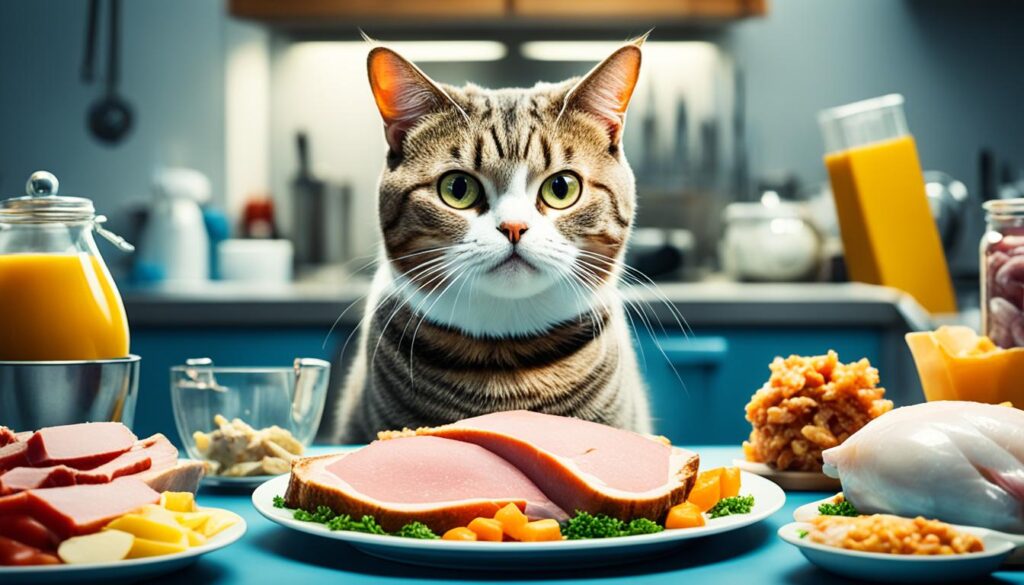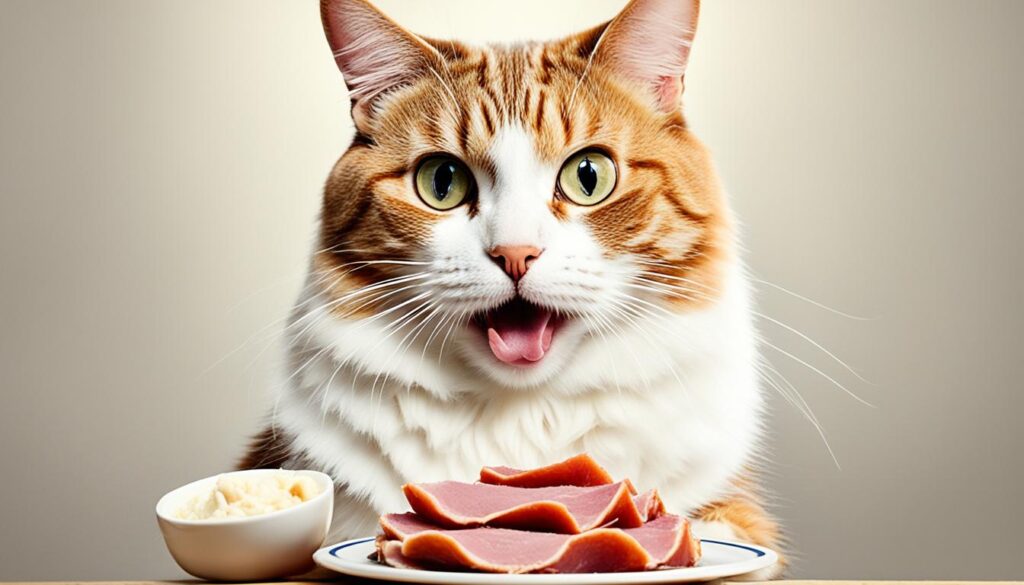As an Amazon Associate I earn from qualifying purchases.
Imagine a quiet evening, you’re slicing ham for dinner. Your feline friend is purring at your feet, eyes locked onto the knife’s dance. We often think, ‘can cats eat ham?’ Is it safe for them, or does it put them at risk? Cats are family, and we must ensure their diet is nutritious. Before giving in to that silent plea, let’s explore what truly benefits our whiskered friends.
Key Takeaways
- Understanding your cat’s diet is critical to their health; not all meats are equally beneficial or safe.
- Ham, though rich in protein, is laden with high fat and sodium which can be harmful to cats when given in large quantities.
- Reserve ham as an occasional treat and stay aware of the balance required in your cat’s feline nutrition.
- Health implications of ham can include obesity and salt poisoning if incorporated regularly in a cat’s diet.
- When considering, ‘can cats eat ham’, moderation and veterinary guidance are essential.
- Safe foods for cats prioritize their intrinsic nutritional needs as obligate carnivores.
Understanding Feline Nutrition: The Basics
To understand what cats can eat, look to their wild ancestors’ diet. Domestic cats need similar nutrients to their wild relatives, who eat mostly meat. This history is key to knowing why foods like cats and ham might not be the best choice.
What Cats Normally Eat in The Wild
In nature, cats hunt and eat a diet rich in protein from rodents, birds, and insects. This diet provides not only protein but also many vital nutrients. Knowing this helps cat owners make smart diet choices for their pets.
Essential Nutrients for Cats’ Diet
A healthy diet for cats at home should match what they’d eat in the wild. They need important nutrients such as:
- Amino Acids: Taurine is essential for heart and eye health.
- Vitamins: Vitamin A is needed for clear vision and a strong immune system.
- Minerals: Iron helps blood carry oxygen, and zinc keeps skin and fur healthy.
- Fatty Acids: Omega-3 and Omega-6 make a cat’s coat shiny and their skin healthy.
When thinking about feeding cats ham, what matters most is the quality and balance of their diet. Let’s look into this more:
| Component | Benefit | Consideration for Domestic Cats |
|---|---|---|
| Protein | Builds muscle and repairs tissue | Choose high-quality sources like chicken, fish, and turkey |
| Fat | Gives energy and helps absorb vitamins | Keep it moderate to avoid obesity and health problems |
| Taurine | Crucial for healthy heart function | Added to most commercial cat foods; needed in raw diets |
| Water | Essential for hydration | Always provide fresh water, especially with dry food |
Understanding cat nutrition shows why we should be cautious with certain foods. Treats like ham, high in salt, may not fit well with a cat’s natural diet and needs. It’s important to keep cat diets balanced and moderate for their health.
Can Cats Eat Ham? Insights and Considerations
Many pet owners care deeply about their cats’ wellbeing and diet. You might ask if can cats eat ham and how it might affect their cat diet. Though ham isn’t poisonous to cats, it’s important to think twice before letting your cat nibble on your ham.
Ham for cats might be okay in tiny amounts, but its high salt and fat could be bad for them. Processed ham, which you buy from stores, is full of preservatives and extra salt. This can be harmful and might even cause salt poisoning in cats.
If you choose to give your cat some ham, pick a high-quality piece. Maybe get it from a well-known butcher. Treat them to it only once in a while and not as a regular part of their meals. Make sure to cook it well to kill off dangerous bacteria like Salmonella or Listeria.
To safely add ham to your cat’s treats, use it very carefully. It could be a special reward or help when giving medicine. Just keep an eye on how much and how often they get it, and always focus on giving your cat a balanced diet for their best health.
Ham isn’t normally in a cat’s diet, but if used wisely, it can be a delightful treat for your furry friend.
The Nutritional Profile of Ham: What’s Inside?
Looking into ham for cats, we must examine its nutritional details. These details impact feline nutrition. While pondering what can cats eat, ham surfaces due to its human food status. Let’s explore ham’s content and its fit for cat diets.
Analyzing Ham’s Protein Content for Cats
Cats need protein for strong muscles and health. A 100g ham serving has about 22.2 grams of protein. This includes taurine, key for heart, eye, and digestion health.
Deciphering Fat and Sodium Levels in Ham
But, ham’s fat and sodium are high. Each 100g carries 977 mg of sodium. This is too much for cats and may cause health issues. The fat could also increase obesity and heart disease risks, so use it sparingly.
Here’s more on ham’s nutrition:
| Nutrient | Content in 100g of Ham |
|---|---|
| Protein | 22.2 g |
| Sodium | 977 mg |
| Fat | Varies (check label) |
| Taurine | Present (specific content varies) |

Health Risks Associated with Cats Consuming Ham
It’s crucial to know which foods are safe for cats and which aren’t. You might wonder, can cats eat ham? Feeding them ham can pose significant health risks due to its salt and fat. These elements might harm your furry friend’s health.

The Impact of Salt Content on Cats
Feeding your cat ham can lead to high salt intake, which is very harmful. This can upset their body’s balance, causing stomach issues or more thirst and urination. In severe cases, too much ham can cause salt poisoning. This is marked by vomiting, tiredness, and seizures. So, it’s best to keep ham out of their diet.
Consequences of High Fat Intake in Felines
The high fat in ham can cause serious health issues for cats. Conditions like obesity, pancreatitis, and heart disease can come from too much fat. Cats’ bodies are very sensitive to fat, which hampers their energy use. Also, some cats need a low-sodium diet and should not eat ham at all. This avoids making certain health problems worse.
| Health Risk | Symptoms | Preventive Measure |
|---|---|---|
| Salt Poisoning | Vomiting, Lethargy, Seizures | Minimal Ham; Fresh Water |
| Obesity | Weight Gain, Difficulty Moving | Diet Control; Exercise |
| Pancreatitis | Abdominal Pain, Decreased Appetite | Low-Fat Diet; Regular Vet Visits |
| Heart Disease | Coughing, Breathing Difficulty | Limited Fat Intake; Check-ups |
In the end, it’s key to give your cat foods that meet nutrition guidelines. While ham might seem like a good treat, the dangers are not worth it. Always choose food made just for cats to keep them healthy.
Answering the Question: How Much Ham Can Cats Safely Consume?
If you are thinking of giving your cat ham, you’re not alone. Many cat owners wonder if it’s safe to share their savory treats. The truth is, cats can have ham, but only in small amounts. For a healthy cat diet, knowing how much ham is safe is key.
Feeding Ham as a Treat: Portion Control Tips
When giving ham to your cat, always think about moderation. Veterinary guidance suggests treats like ham should be less than 10% of your cat’s daily food. Typically, this means a small piece of ham, about 18 grams, is enough. It’s best to give this treat just once or twice a week to avoid too many calories and salt. Ensure the ham is plain and fully cooked to avoid any health issues.
Understanding The Occasional Nature of Ham in A Cat’s Diet
Always remember, regular cat meals should be complete and balanced. Ham is only a treat and shouldn’t be given often. Watch closely for any signs of food intolerance, such as vomiting or diarrhea, after your cat eats ham. If you want to try new foods in your cat’s diet, talk to a vet. They can help make sure your cat stays healthy and happy.
FAQ
Can cats eat ham safely as part of their diet?
What do cats normally eat in the wild?
What are the essential nutrients that cats need in their diet?
What is the nutritional profile of ham, and is it beneficial for cats?
What are the health risks associated with feeding ham to cats?
How much ham can cats safely consume?
Is it necessary to cook ham before feeding it to cats?
Are there any cats that should not have ham at all?
Could ham bones pose a danger to my cat?
What signs should I look out for if I’ve fed my cat ham?
As an Amazon Associate I earn from qualifying purchases.

